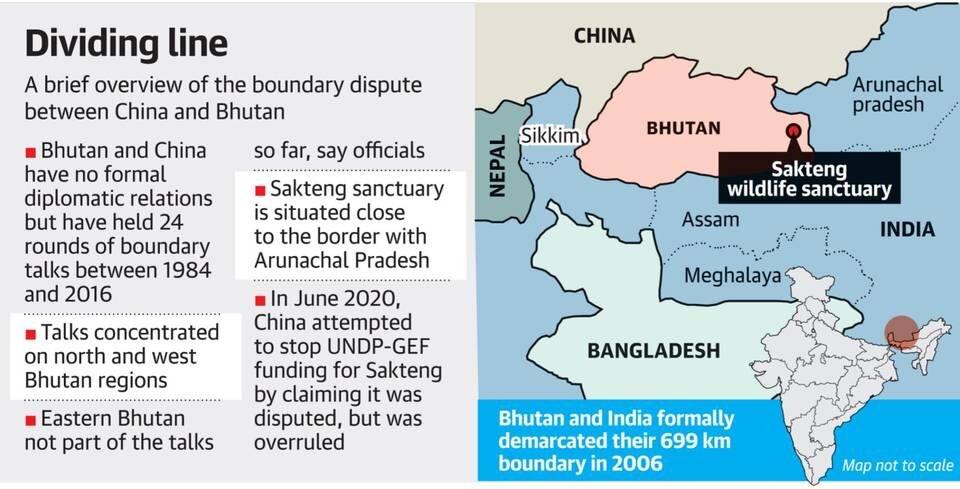New Bhutanese Territory Claimed by China | 06 Jul 2020
Why in News
Recently, China has made new territorial claims in the eastern sector of Bhutan’s Trashigang district.
Key Points
- Territorial Claim of China:
- China made this claim at an online meeting of the 58th Global Environment Facility (GEF) Council, while objecting to the funding request to develop the Sakteng Wildlife Sanctuary project in eastern Bhutan.
- However, GEF cleared the funding to the project after Bhutan protested against the Chinese claims.
- Set up in 1992, GEF is a US-based global body to finance projects in the environment sector.
- According to China, the Sakteng Wildlife Sanctuary is located in the China-Bhutan disputed areas which is on the agenda of China-Bhutan boundary talk.
- China claims that the boundary between China and Bhutan has never been delimited. It has had disputes over the eastern, central and western sectors of Bhutan.
- China made this claim at an online meeting of the 58th Global Environment Facility (GEF) Council, while objecting to the funding request to develop the Sakteng Wildlife Sanctuary project in eastern Bhutan.
- Bhutan’s Position:
- Bhutan totally rejected the claim made by China. It said that Sakteng Wildlife Sanctuary is an integral and sovereign territory of Bhutan.
- Also, Sakteng Sanctuary in the past too has received such grants, including in 2018-2019, for a project on preventing soil erosion, without any objection from China.
- Bhutan has conveyed its position to China through its embassy in New Delhi— since both countries don’t have embassies in each other’s countries.
- Bhutan and China do not have any formal diplomatic relations, both the countries conduct their diplomatic communication through their missions in Delhi.
- China and Bhutan have a dispute in only two sectors of the border, one in the north (central) – Pasamlung and Jakarlung, and second in the west – Doklam.
- There has been no mention of eastern Bhutan, or Trashigang district, where Sakteng is based, in 24 previous rounds of boundary negotiations held between the two countries between 1984 and 2016.
- Bhutan totally rejected the claim made by China. It said that Sakteng Wildlife Sanctuary is an integral and sovereign territory of Bhutan.
- Concerns for India:
- China’s new territorial claim is a part of the larger Chinese tactics of putting pressure on India’s smaller neighbours, to punish them for any closeness to India.
- In 2017 China had intruded into Doklam plateau, which is claimed by Bhutan, leading to a standoff between Indian and Chinese Armies.
- China might be doing this to put a pressure on India, or to divert India’s attention from its aggression at Ladakh.
- Sakteng is situated along the border with Arunachal Pradesh, some part of which is also claimed by China.
- Even after the India-Bhutan Friendship Treaty of 2007, Indian military is virtually responsible for protecting Bhutan from the kind of external threat that the Chinese military poses.
- According to the India-Bhutan Friendship Treaty of 1949, Bhutan allowed India to "guide" its foreign policy and defence affairs.
- However, the 1949 treaty was amended in 2007 to respect the sensitivities of Bhutan regarding its sovereignty.
- Under the India-Bhutan Friendship Treaty of 2007, the two sides have agreed to cooperate closely with each other on issues relating to their national interests.
- Neither Government shall allow the use of its territory for activities harmful to the national security and interest of the other.
- China has said that a third party should not point fingers in the China-Bhutan border issue, which is an apparent reference to India.
- China’s new territorial claim is a part of the larger Chinese tactics of putting pressure on India’s smaller neighbours, to punish them for any closeness to India.
Way Forward
- Bhutan has protested against Chinese territorial claims in eastern Bhutan and said that it will also contest in future if China refers to the territory as disputed.
- Safety of Border from China is a concern for both India and Bhutan. Therefore, both sides need to work together on this issue.

